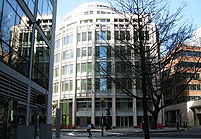From time to time I remember the essay question :
“Original research = intelligent plagiarism. Discuss”. Particularly, it comes to mind whenever I come across disparate pieces of information and want to link them. The link in what follows is Sunday (day of the week) and buildings (or rather pictures of buildings) : no claim is made to originality (or intelligence).
On Sunday last (so August 2014) I went to
the exhibition at the National Portrait Gallery titled “Virginia Woolf : Art, Life and Vision A few days earlier I had read the exciting post of Eleonora Rosati on IPKat [
Thursday, 21 August 2014 : Taking a selfie inside the National Gallery: a copyright infringement? ] which brought the news that “following similar moves by a number of other UK institutions .... the National Gallery in London has changed its strict no-photos-(please) policy”.
Was it the case (I asked myself) that the National Portrait
Gallery was one of the “other UK institutions” ? Could I (for example) place myself
in front of T.S. Eliot in this photograph and take a selfie of Virginia Woolf
leaning towards me (replacing T.S. Eliot)?
Alas, the website of the National Portrait Gallery is clear that
“Photography is not permitted in temporary exhibitions or displays with loans”

So no photograph. But two thoughts :
1) on period of copyright : the line (bottom of the
photograph on the website) is (C) National Portrait Gallery London. Lady
Ottoline Morrell took the photograph of Eliot and Woolf in 1924. She died in
1938. So copyright expired in 2008 ?
20 on Representation of
certain artistic works on public display” :
Section 62 Copyright,Designs and Patents Act 1988 ('CDPA') applies to “buildings” and provides
that “The copyright in such .... is not infringed by ...... making a photograph
... of it”. The follow-on is that “ Nor is the copyright infringed by
the issue to the public of copies, or the communication to the public, of
anything whose making was, by virtue of this section, not an infringement
of the copyright”. So presumably I can take a photograph of the building that
is the National Portrait Gallery and include that photograph in a (greetings)
card which I post (online) on social media and post (envelope-with-stamp) to
family and friends and others WITHOUT risk of an allegation of copyright
infringement ?
On
Sunday a couple of years ago (September 2012) I visited
Spa in Belgium for the
F1 Grand Prix and took a seat in the stand at
Eau Rouge (being an “uphill corner”
on the circuit). So a chord was struck when
Lee Curtis published on the
Linked In Group of Automotives+ IP news that “ ....
Infiniti have applied to register the trade mark EAU ROUGE in the US for cars,
despite the fact the mark has been registered in the EU by the famous race
track”
The detail that attracted attention was Lee’s reference to “the UKIPO practice on the registration of the names of famous buildings”. The relevant paragraph in the Manual – headed FAMOUS BUILDINGS (
Pictorial representations (emphasis supplied) or names of well known buildings) - contains the text :
“traders in the area of a famous building, which is likely to be a tourist attraction, should be free to produce mementos and ornaments bearing the name or representation (emphasis supplied) of the building without infringing the rights of another."
Also the text :
“if the building is a tourist attraction then the objection should be raised”.
As to where it leads :
A) If I take a photograph of the building that is the National Portrait Gallery and thereafter distribute this photograph – the law of copyright sanctions this activity : section 62 CDPA 1988 (above)
B) If I take a photograph of the building that is the National Portrait Gallery and try to register this (representation) as a trade mark at the UK Trade Mark Registry, there is likely to be discussion with the Registry as to whether the mark applied for is a famous building / tourist attraction : see Manual / UKIPO practice (above)
C) The interests of the National Portrait Gallery lie in the UK Trade Mark Registry coming to the conclusion that the building that is the National Portrait Gallery is a famous building / tourist attraction so that my attempt to register is refused
D) But such a conclusion means (presumably) that an Application of the National Portrait Gallery to try to register a photograph of the building that is the National Portrait Gallery must also fail.
So (I ask myself) will the public-spirited owners of buildings which have a “Photographic Policy” be amending same with the note “This building is a famous building / tourist attraction” in the hope this deflects / reduces the possibility of a photograph (representation) of that building being registered by a third party as a trade mark ?












_-_14.jpg)

